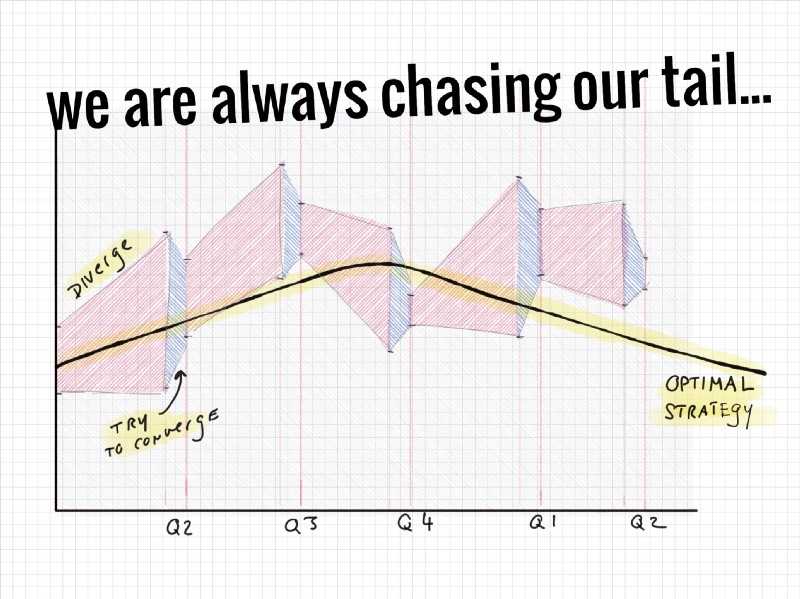Does your company use quarterly OKRs?
Are they working for you?
Why did you pick 90.25 day batch sizes? Do all of your objectives take 90.25 days (or more accurately ~65 business days)? How many days do you spend “resetting” for the next quarter?
Here’s a thought… quarterly OKRs are like quarterly “sprints”. Some teams do well with sprints, but other teams prefer continuous flow, just-in-time planning, and conducting retrospectives/recalibrating as needed. Or hybrid models.
But quarterly planning is so painful! I don’t want to do it more frequently!Maybe that’s a hint. Frequency reduces difficulty! Or put more colloquially…if it hurts, do it more often. Perhaps quarterly planning hurts because it happens too infrequently (and at an artificial cadence).
The “drift” might be too great…
Imagine a continuous planning model whereby a company has rolling 6 and 12 month goals. Guiding points on the horizon are always visible. When some aspect of reality changes, the points shift. Teams tackle goals/objectives of variable lengths — one day, 12 days, two months, four months — and recalibrate as necessary. Might that work better?
But quarters are the heartbeat of business!Really? All aspects of business?
OK, let’s say you’re right. I want to go back to the idea of mixing continuous flow with certain cadenced events/rituals. Imagine every team has a rolling twelve month map of core bets, sub bets, and sub-sub bets. It is always right, and always extends to the next twelve months. This doesn’t stop you checking in once a quarter. But you are decoupling that checkin from the cadence (or mixed cadences) of your objectives.
Notice here how you can have all sorts of cycles/cadences/triggers running at once. You have a finance cadence, product cadence, cross-functional effort focus, recruiting, and workplace happiness streams. Should they all operate on a 90.25 day cadence, or on a cadence at all?
In closing…over the years I have seen many teams shift from pushed batch / fixed timebox models to continuous flow-based models. That’s not to say that fixed timebox models aren’t useful and absolutely applicable in some contexts, but rather to say that alternatives exist. Might we extend that to high level company planning as well?
We seem to take the quarterly OKR as gospel, and all gospels should be challenged.
Jason asks the right question:
I would respond that it is almost impossible to generalize. 90.25 days might be perfect for your company, 60 for the next, 30 for the next, or variable length periods for the next. This is a case where your org IS unique, and you should customize your tools.
Generalization/forced-convergence always suggests opportunities for beneficial customization and better reflecting reality.

